Report on Organizational Behavior: Socialization, Tactics, and Issues
VerifiedAdded on 2021/05/31
|10
|2591
|195
Report
AI Summary
This report provides a comprehensive overview of organizational socialization, a critical process for integrating new employees. It explores various socialization tactics, such as collective versus individual and sequential versus random, and their impact on newcomers. The report highlights the role of colleagues in facilitating newcomer socialization, emphasizing the importance of a supportive work environment and proactive behavior from new employees. It also discusses the most useful findings in organizational socialization research, including the anxiety-provoking nature of organizational entry and the benefits of proactive behavior. Furthermore, the report identifies issues not addressed by organizational socialization, such as lifestyle concerns and communication barriers. The report concludes with a management report that underscores the value of investing in socialization programs and offers recommendations for fostering a positive and effective socialization process, including providing support, using positive framing, and implementing training programs. The references cited provide further insights into the research and concepts discussed.
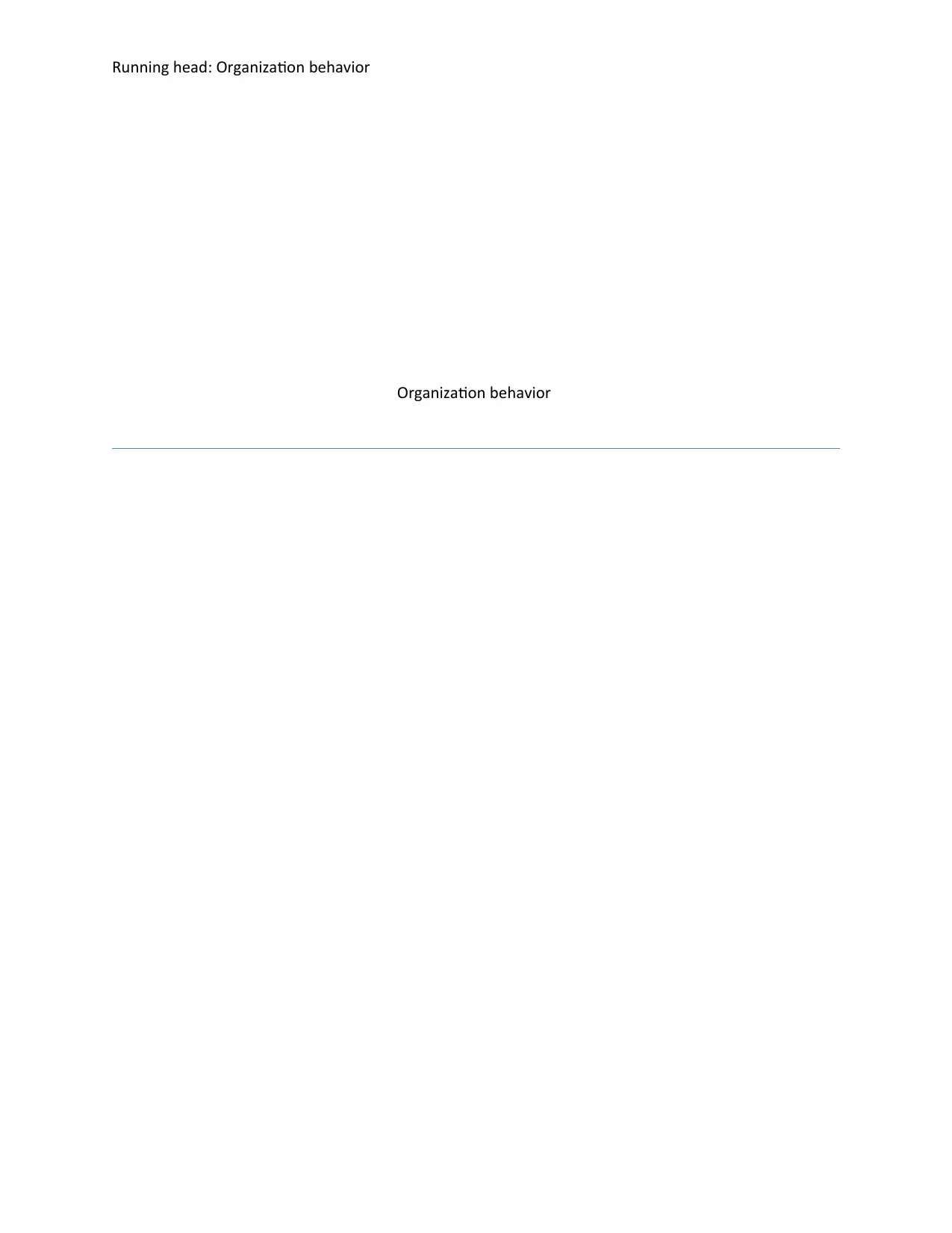
Running head: Organization behavior
Organization behavior
Organization behavior
Paraphrase This Document
Need a fresh take? Get an instant paraphrase of this document with our AI Paraphraser
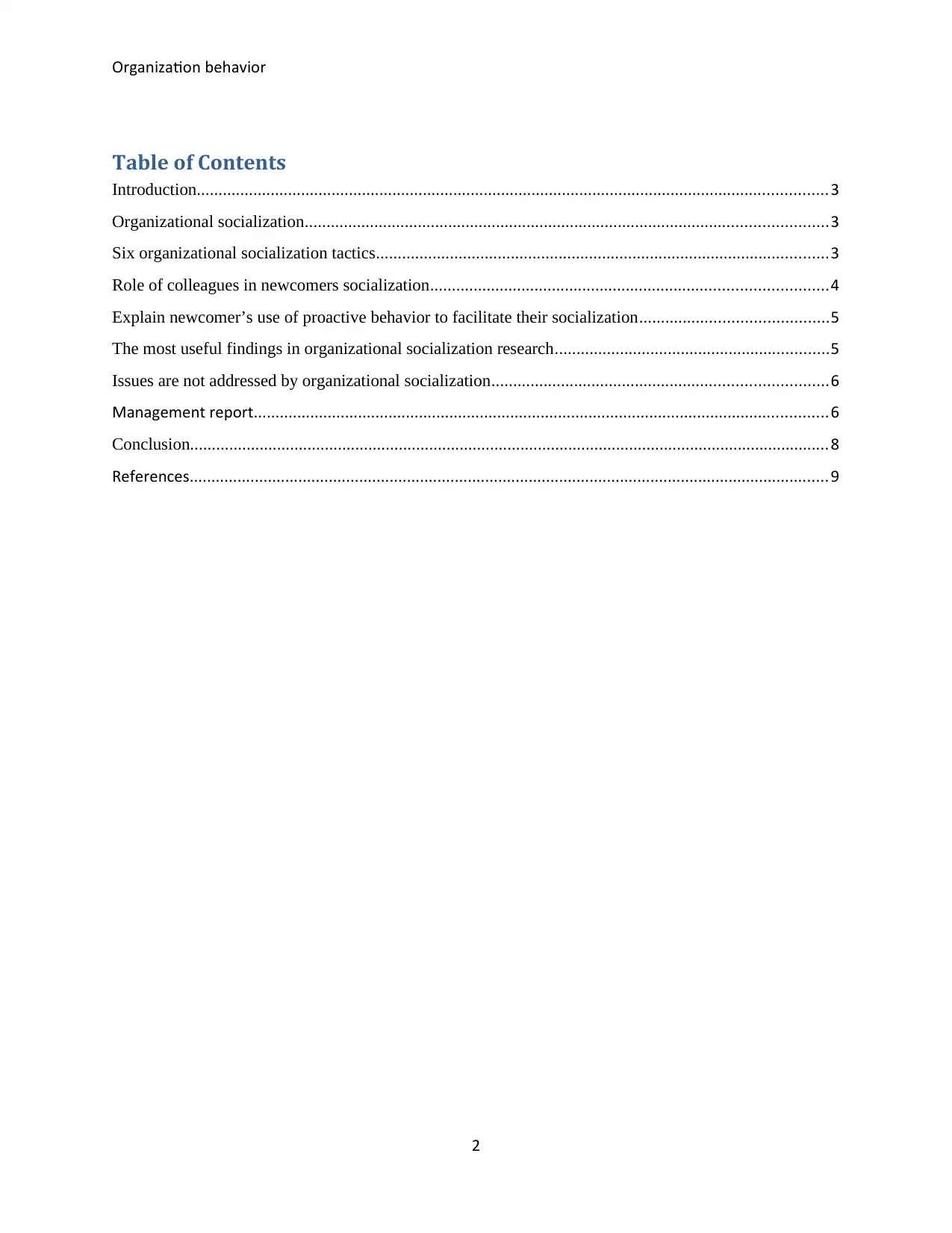
Organization behavior
Table of Contents
Introduction.................................................................................................................................................3
Organizational socialization........................................................................................................................3
Six organizational socialization tactics........................................................................................................3
Role of colleagues in newcomers socialization...........................................................................................4
Explain newcomer’s use of proactive behavior to facilitate their socialization...........................................5
The most useful findings in organizational socialization research...............................................................5
Issues are not addressed by organizational socialization.............................................................................6
Management report....................................................................................................................................6
Conclusion...................................................................................................................................................8
References...................................................................................................................................................9
2
Table of Contents
Introduction.................................................................................................................................................3
Organizational socialization........................................................................................................................3
Six organizational socialization tactics........................................................................................................3
Role of colleagues in newcomers socialization...........................................................................................4
Explain newcomer’s use of proactive behavior to facilitate their socialization...........................................5
The most useful findings in organizational socialization research...............................................................5
Issues are not addressed by organizational socialization.............................................................................6
Management report....................................................................................................................................6
Conclusion...................................................................................................................................................8
References...................................................................................................................................................9
2
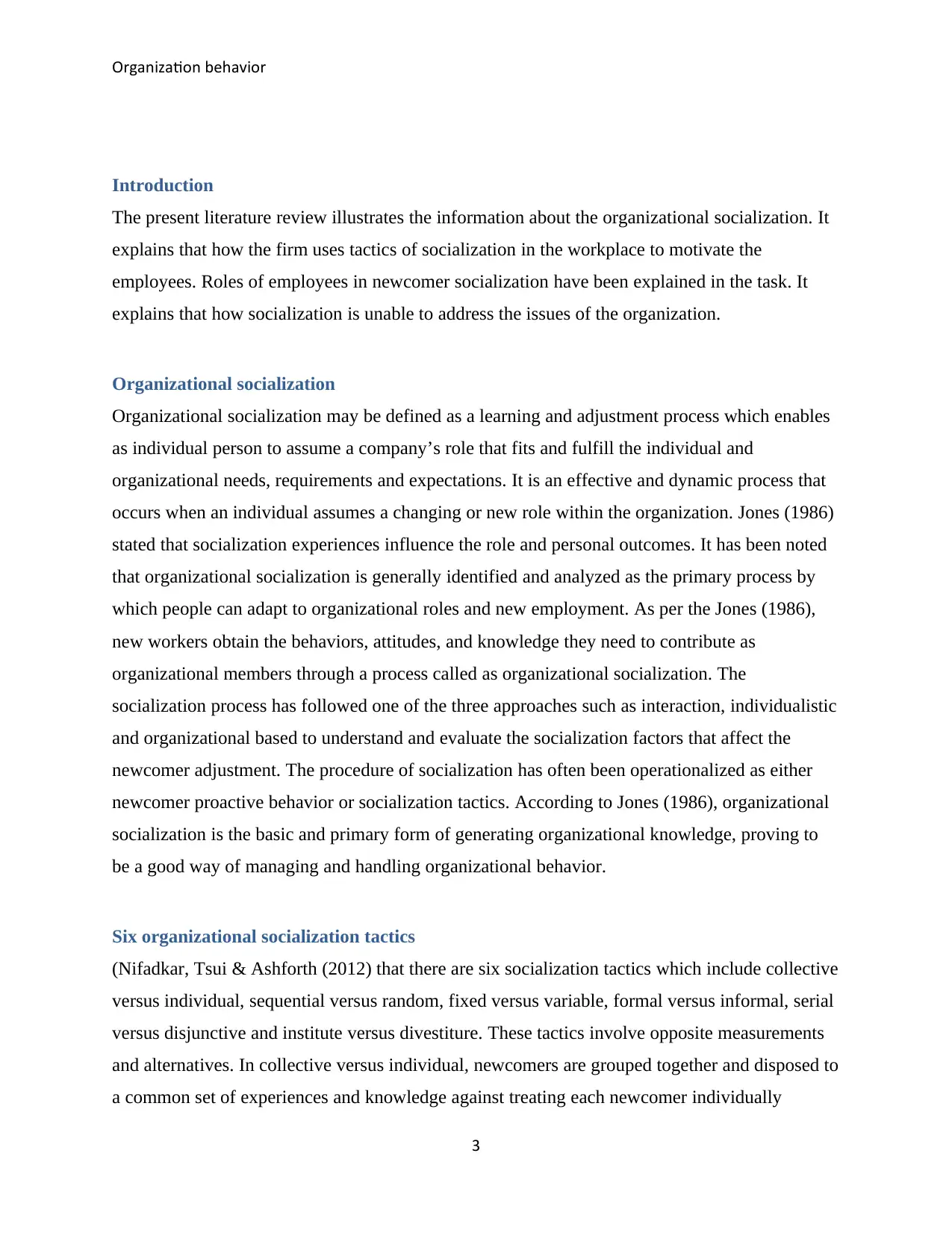
Organization behavior
Introduction
The present literature review illustrates the information about the organizational socialization. It
explains that how the firm uses tactics of socialization in the workplace to motivate the
employees. Roles of employees in newcomer socialization have been explained in the task. It
explains that how socialization is unable to address the issues of the organization.
Organizational socialization
Organizational socialization may be defined as a learning and adjustment process which enables
as individual person to assume a company’s role that fits and fulfill the individual and
organizational needs, requirements and expectations. It is an effective and dynamic process that
occurs when an individual assumes a changing or new role within the organization. Jones (1986)
stated that socialization experiences influence the role and personal outcomes. It has been noted
that organizational socialization is generally identified and analyzed as the primary process by
which people can adapt to organizational roles and new employment. As per the Jones (1986),
new workers obtain the behaviors, attitudes, and knowledge they need to contribute as
organizational members through a process called as organizational socialization. The
socialization process has followed one of the three approaches such as interaction, individualistic
and organizational based to understand and evaluate the socialization factors that affect the
newcomer adjustment. The procedure of socialization has often been operationalized as either
newcomer proactive behavior or socialization tactics. According to Jones (1986), organizational
socialization is the basic and primary form of generating organizational knowledge, proving to
be a good way of managing and handling organizational behavior.
Six organizational socialization tactics
(Nifadkar, Tsui & Ashforth (2012) that there are six socialization tactics which include collective
versus individual, sequential versus random, fixed versus variable, formal versus informal, serial
versus disjunctive and institute versus divestiture. These tactics involve opposite measurements
and alternatives. In collective versus individual, newcomers are grouped together and disposed to
a common set of experiences and knowledge against treating each newcomer individually
3
Introduction
The present literature review illustrates the information about the organizational socialization. It
explains that how the firm uses tactics of socialization in the workplace to motivate the
employees. Roles of employees in newcomer socialization have been explained in the task. It
explains that how socialization is unable to address the issues of the organization.
Organizational socialization
Organizational socialization may be defined as a learning and adjustment process which enables
as individual person to assume a company’s role that fits and fulfill the individual and
organizational needs, requirements and expectations. It is an effective and dynamic process that
occurs when an individual assumes a changing or new role within the organization. Jones (1986)
stated that socialization experiences influence the role and personal outcomes. It has been noted
that organizational socialization is generally identified and analyzed as the primary process by
which people can adapt to organizational roles and new employment. As per the Jones (1986),
new workers obtain the behaviors, attitudes, and knowledge they need to contribute as
organizational members through a process called as organizational socialization. The
socialization process has followed one of the three approaches such as interaction, individualistic
and organizational based to understand and evaluate the socialization factors that affect the
newcomer adjustment. The procedure of socialization has often been operationalized as either
newcomer proactive behavior or socialization tactics. According to Jones (1986), organizational
socialization is the basic and primary form of generating organizational knowledge, proving to
be a good way of managing and handling organizational behavior.
Six organizational socialization tactics
(Nifadkar, Tsui & Ashforth (2012) that there are six socialization tactics which include collective
versus individual, sequential versus random, fixed versus variable, formal versus informal, serial
versus disjunctive and institute versus divestiture. These tactics involve opposite measurements
and alternatives. In collective versus individual, newcomers are grouped together and disposed to
a common set of experiences and knowledge against treating each newcomer individually
3
⊘ This is a preview!⊘
Do you want full access?
Subscribe today to unlock all pages.

Trusted by 1+ million students worldwide
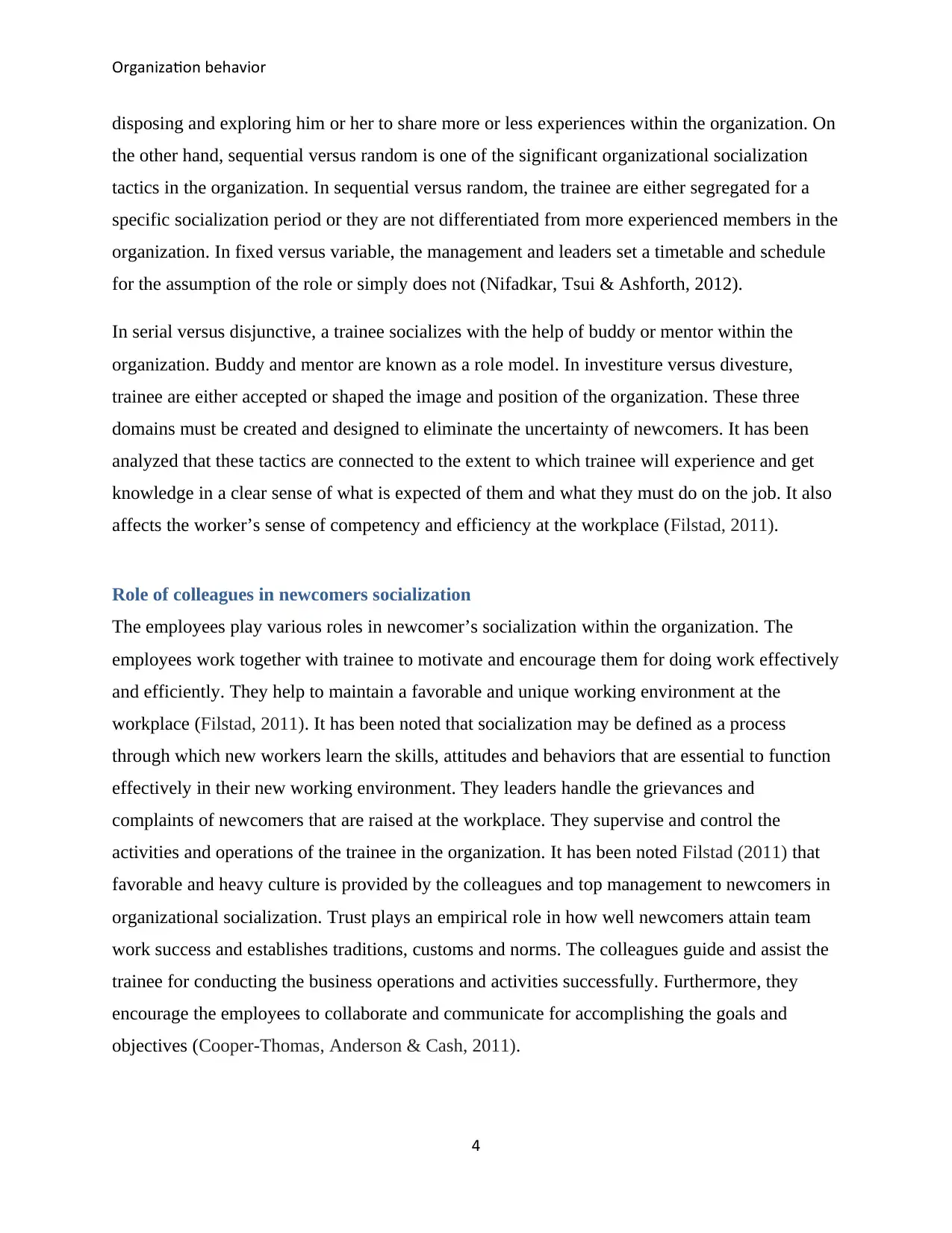
Organization behavior
disposing and exploring him or her to share more or less experiences within the organization. On
the other hand, sequential versus random is one of the significant organizational socialization
tactics in the organization. In sequential versus random, the trainee are either segregated for a
specific socialization period or they are not differentiated from more experienced members in the
organization. In fixed versus variable, the management and leaders set a timetable and schedule
for the assumption of the role or simply does not (Nifadkar, Tsui & Ashforth, 2012).
In serial versus disjunctive, a trainee socializes with the help of buddy or mentor within the
organization. Buddy and mentor are known as a role model. In investiture versus divesture,
trainee are either accepted or shaped the image and position of the organization. These three
domains must be created and designed to eliminate the uncertainty of newcomers. It has been
analyzed that these tactics are connected to the extent to which trainee will experience and get
knowledge in a clear sense of what is expected of them and what they must do on the job. It also
affects the worker’s sense of competency and efficiency at the workplace (Filstad, 2011).
Role of colleagues in newcomers socialization
The employees play various roles in newcomer’s socialization within the organization. The
employees work together with trainee to motivate and encourage them for doing work effectively
and efficiently. They help to maintain a favorable and unique working environment at the
workplace (Filstad, 2011). It has been noted that socialization may be defined as a process
through which new workers learn the skills, attitudes and behaviors that are essential to function
effectively in their new working environment. They leaders handle the grievances and
complaints of newcomers that are raised at the workplace. They supervise and control the
activities and operations of the trainee in the organization. It has been noted Filstad (2011) that
favorable and heavy culture is provided by the colleagues and top management to newcomers in
organizational socialization. Trust plays an empirical role in how well newcomers attain team
work success and establishes traditions, customs and norms. The colleagues guide and assist the
trainee for conducting the business operations and activities successfully. Furthermore, they
encourage the employees to collaborate and communicate for accomplishing the goals and
objectives (Cooper-Thomas, Anderson & Cash, 2011).
4
disposing and exploring him or her to share more or less experiences within the organization. On
the other hand, sequential versus random is one of the significant organizational socialization
tactics in the organization. In sequential versus random, the trainee are either segregated for a
specific socialization period or they are not differentiated from more experienced members in the
organization. In fixed versus variable, the management and leaders set a timetable and schedule
for the assumption of the role or simply does not (Nifadkar, Tsui & Ashforth, 2012).
In serial versus disjunctive, a trainee socializes with the help of buddy or mentor within the
organization. Buddy and mentor are known as a role model. In investiture versus divesture,
trainee are either accepted or shaped the image and position of the organization. These three
domains must be created and designed to eliminate the uncertainty of newcomers. It has been
analyzed that these tactics are connected to the extent to which trainee will experience and get
knowledge in a clear sense of what is expected of them and what they must do on the job. It also
affects the worker’s sense of competency and efficiency at the workplace (Filstad, 2011).
Role of colleagues in newcomers socialization
The employees play various roles in newcomer’s socialization within the organization. The
employees work together with trainee to motivate and encourage them for doing work effectively
and efficiently. They help to maintain a favorable and unique working environment at the
workplace (Filstad, 2011). It has been noted that socialization may be defined as a process
through which new workers learn the skills, attitudes and behaviors that are essential to function
effectively in their new working environment. They leaders handle the grievances and
complaints of newcomers that are raised at the workplace. They supervise and control the
activities and operations of the trainee in the organization. It has been noted Filstad (2011) that
favorable and heavy culture is provided by the colleagues and top management to newcomers in
organizational socialization. Trust plays an empirical role in how well newcomers attain team
work success and establishes traditions, customs and norms. The colleagues guide and assist the
trainee for conducting the business operations and activities successfully. Furthermore, they
encourage the employees to collaborate and communicate for accomplishing the goals and
objectives (Cooper-Thomas, Anderson & Cash, 2011).
4
Paraphrase This Document
Need a fresh take? Get an instant paraphrase of this document with our AI Paraphraser
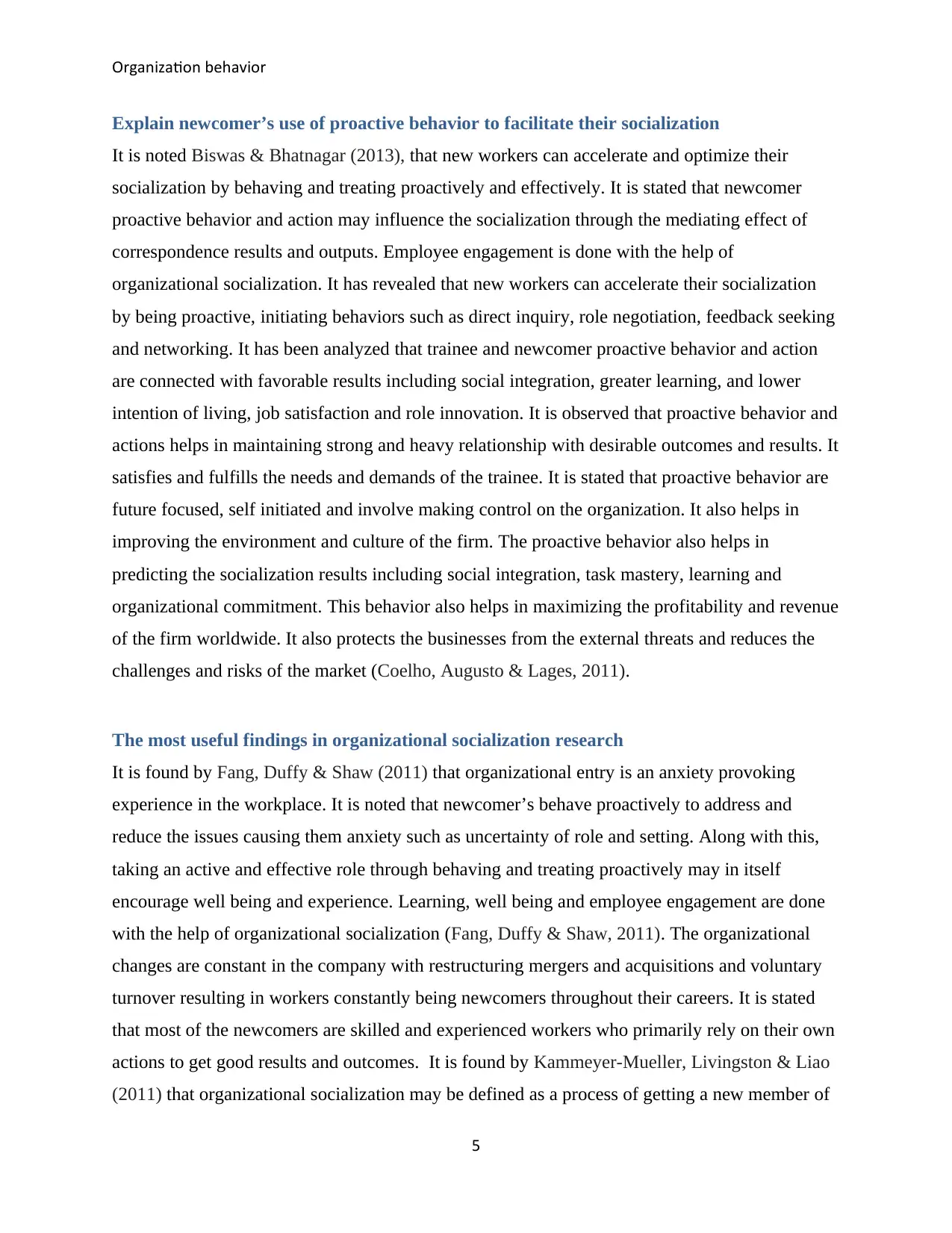
Organization behavior
Explain newcomer’s use of proactive behavior to facilitate their socialization
It is noted Biswas & Bhatnagar (2013), that new workers can accelerate and optimize their
socialization by behaving and treating proactively and effectively. It is stated that newcomer
proactive behavior and action may influence the socialization through the mediating effect of
correspondence results and outputs. Employee engagement is done with the help of
organizational socialization. It has revealed that new workers can accelerate their socialization
by being proactive, initiating behaviors such as direct inquiry, role negotiation, feedback seeking
and networking. It has been analyzed that trainee and newcomer proactive behavior and action
are connected with favorable results including social integration, greater learning, and lower
intention of living, job satisfaction and role innovation. It is observed that proactive behavior and
actions helps in maintaining strong and heavy relationship with desirable outcomes and results. It
satisfies and fulfills the needs and demands of the trainee. It is stated that proactive behavior are
future focused, self initiated and involve making control on the organization. It also helps in
improving the environment and culture of the firm. The proactive behavior also helps in
predicting the socialization results including social integration, task mastery, learning and
organizational commitment. This behavior also helps in maximizing the profitability and revenue
of the firm worldwide. It also protects the businesses from the external threats and reduces the
challenges and risks of the market (Coelho, Augusto & Lages, 2011).
The most useful findings in organizational socialization research
It is found by Fang, Duffy & Shaw (2011) that organizational entry is an anxiety provoking
experience in the workplace. It is noted that newcomer’s behave proactively to address and
reduce the issues causing them anxiety such as uncertainty of role and setting. Along with this,
taking an active and effective role through behaving and treating proactively may in itself
encourage well being and experience. Learning, well being and employee engagement are done
with the help of organizational socialization (Fang, Duffy & Shaw, 2011). The organizational
changes are constant in the company with restructuring mergers and acquisitions and voluntary
turnover resulting in workers constantly being newcomers throughout their careers. It is stated
that most of the newcomers are skilled and experienced workers who primarily rely on their own
actions to get good results and outcomes. It is found by Kammeyer-Mueller, Livingston & Liao
(2011) that organizational socialization may be defined as a process of getting a new member of
5
Explain newcomer’s use of proactive behavior to facilitate their socialization
It is noted Biswas & Bhatnagar (2013), that new workers can accelerate and optimize their
socialization by behaving and treating proactively and effectively. It is stated that newcomer
proactive behavior and action may influence the socialization through the mediating effect of
correspondence results and outputs. Employee engagement is done with the help of
organizational socialization. It has revealed that new workers can accelerate their socialization
by being proactive, initiating behaviors such as direct inquiry, role negotiation, feedback seeking
and networking. It has been analyzed that trainee and newcomer proactive behavior and action
are connected with favorable results including social integration, greater learning, and lower
intention of living, job satisfaction and role innovation. It is observed that proactive behavior and
actions helps in maintaining strong and heavy relationship with desirable outcomes and results. It
satisfies and fulfills the needs and demands of the trainee. It is stated that proactive behavior are
future focused, self initiated and involve making control on the organization. It also helps in
improving the environment and culture of the firm. The proactive behavior also helps in
predicting the socialization results including social integration, task mastery, learning and
organizational commitment. This behavior also helps in maximizing the profitability and revenue
of the firm worldwide. It also protects the businesses from the external threats and reduces the
challenges and risks of the market (Coelho, Augusto & Lages, 2011).
The most useful findings in organizational socialization research
It is found by Fang, Duffy & Shaw (2011) that organizational entry is an anxiety provoking
experience in the workplace. It is noted that newcomer’s behave proactively to address and
reduce the issues causing them anxiety such as uncertainty of role and setting. Along with this,
taking an active and effective role through behaving and treating proactively may in itself
encourage well being and experience. Learning, well being and employee engagement are done
with the help of organizational socialization (Fang, Duffy & Shaw, 2011). The organizational
changes are constant in the company with restructuring mergers and acquisitions and voluntary
turnover resulting in workers constantly being newcomers throughout their careers. It is stated
that most of the newcomers are skilled and experienced workers who primarily rely on their own
actions to get good results and outcomes. It is found by Kammeyer-Mueller, Livingston & Liao
(2011) that organizational socialization may be defined as a process of getting a new member of
5
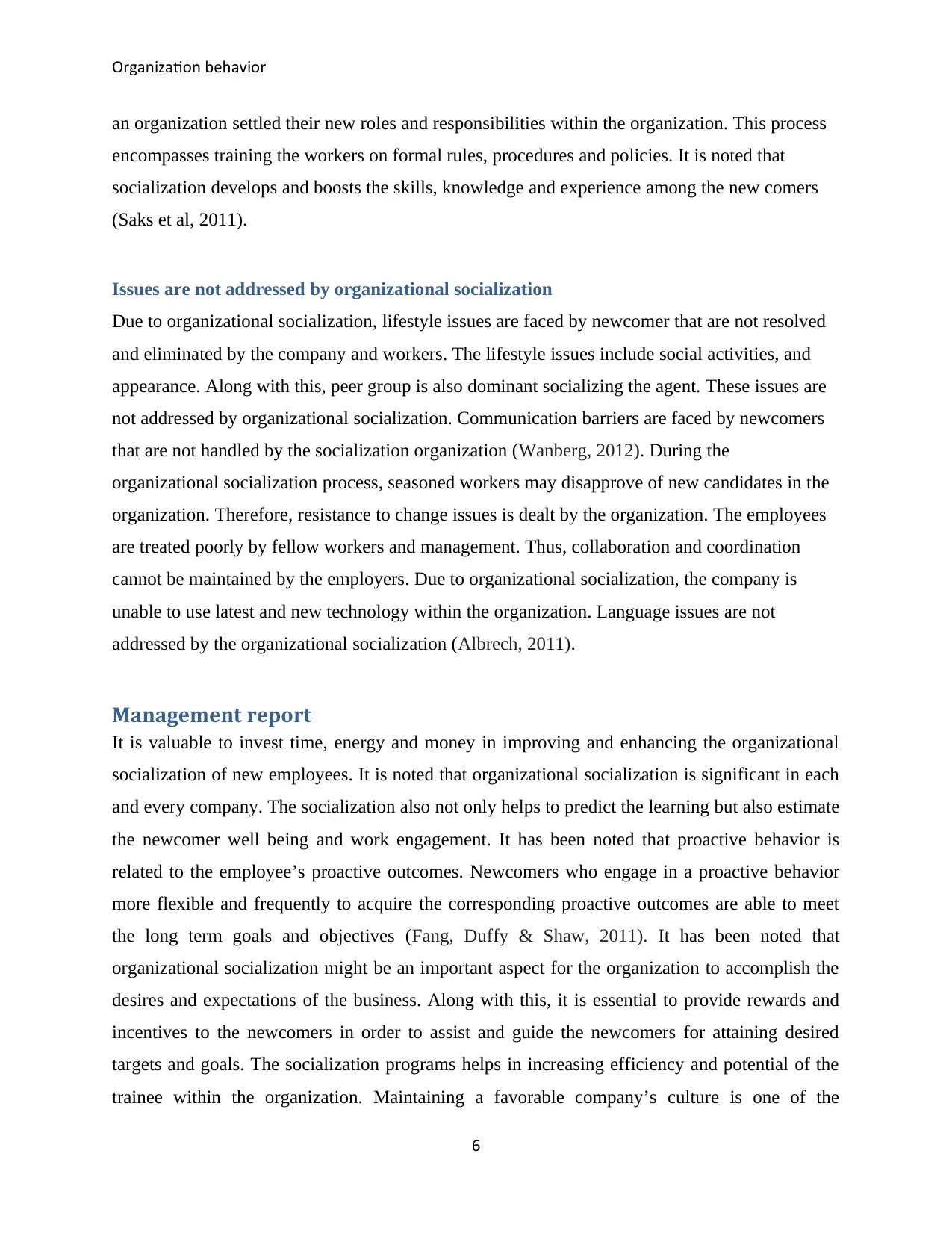
Organization behavior
an organization settled their new roles and responsibilities within the organization. This process
encompasses training the workers on formal rules, procedures and policies. It is noted that
socialization develops and boosts the skills, knowledge and experience among the new comers
(Saks et al, 2011).
Issues are not addressed by organizational socialization
Due to organizational socialization, lifestyle issues are faced by newcomer that are not resolved
and eliminated by the company and workers. The lifestyle issues include social activities, and
appearance. Along with this, peer group is also dominant socializing the agent. These issues are
not addressed by organizational socialization. Communication barriers are faced by newcomers
that are not handled by the socialization organization (Wanberg, 2012). During the
organizational socialization process, seasoned workers may disapprove of new candidates in the
organization. Therefore, resistance to change issues is dealt by the organization. The employees
are treated poorly by fellow workers and management. Thus, collaboration and coordination
cannot be maintained by the employers. Due to organizational socialization, the company is
unable to use latest and new technology within the organization. Language issues are not
addressed by the organizational socialization (Albrech, 2011).
Management report
It is valuable to invest time, energy and money in improving and enhancing the organizational
socialization of new employees. It is noted that organizational socialization is significant in each
and every company. The socialization also not only helps to predict the learning but also estimate
the newcomer well being and work engagement. It has been noted that proactive behavior is
related to the employee’s proactive outcomes. Newcomers who engage in a proactive behavior
more flexible and frequently to acquire the corresponding proactive outcomes are able to meet
the long term goals and objectives (Fang, Duffy & Shaw, 2011). It has been noted that
organizational socialization might be an important aspect for the organization to accomplish the
desires and expectations of the business. Along with this, it is essential to provide rewards and
incentives to the newcomers in order to assist and guide the newcomers for attaining desired
targets and goals. The socialization programs helps in increasing efficiency and potential of the
trainee within the organization. Maintaining a favorable company’s culture is one of the
6
an organization settled their new roles and responsibilities within the organization. This process
encompasses training the workers on formal rules, procedures and policies. It is noted that
socialization develops and boosts the skills, knowledge and experience among the new comers
(Saks et al, 2011).
Issues are not addressed by organizational socialization
Due to organizational socialization, lifestyle issues are faced by newcomer that are not resolved
and eliminated by the company and workers. The lifestyle issues include social activities, and
appearance. Along with this, peer group is also dominant socializing the agent. These issues are
not addressed by organizational socialization. Communication barriers are faced by newcomers
that are not handled by the socialization organization (Wanberg, 2012). During the
organizational socialization process, seasoned workers may disapprove of new candidates in the
organization. Therefore, resistance to change issues is dealt by the organization. The employees
are treated poorly by fellow workers and management. Thus, collaboration and coordination
cannot be maintained by the employers. Due to organizational socialization, the company is
unable to use latest and new technology within the organization. Language issues are not
addressed by the organizational socialization (Albrech, 2011).
Management report
It is valuable to invest time, energy and money in improving and enhancing the organizational
socialization of new employees. It is noted that organizational socialization is significant in each
and every company. The socialization also not only helps to predict the learning but also estimate
the newcomer well being and work engagement. It has been noted that proactive behavior is
related to the employee’s proactive outcomes. Newcomers who engage in a proactive behavior
more flexible and frequently to acquire the corresponding proactive outcomes are able to meet
the long term goals and objectives (Fang, Duffy & Shaw, 2011). It has been noted that
organizational socialization might be an important aspect for the organization to accomplish the
desires and expectations of the business. Along with this, it is essential to provide rewards and
incentives to the newcomers in order to assist and guide the newcomers for attaining desired
targets and goals. The socialization programs helps in increasing efficiency and potential of the
trainee within the organization. Maintaining a favorable company’s culture is one of the
6
⊘ This is a preview!⊘
Do you want full access?
Subscribe today to unlock all pages.

Trusted by 1+ million students worldwide
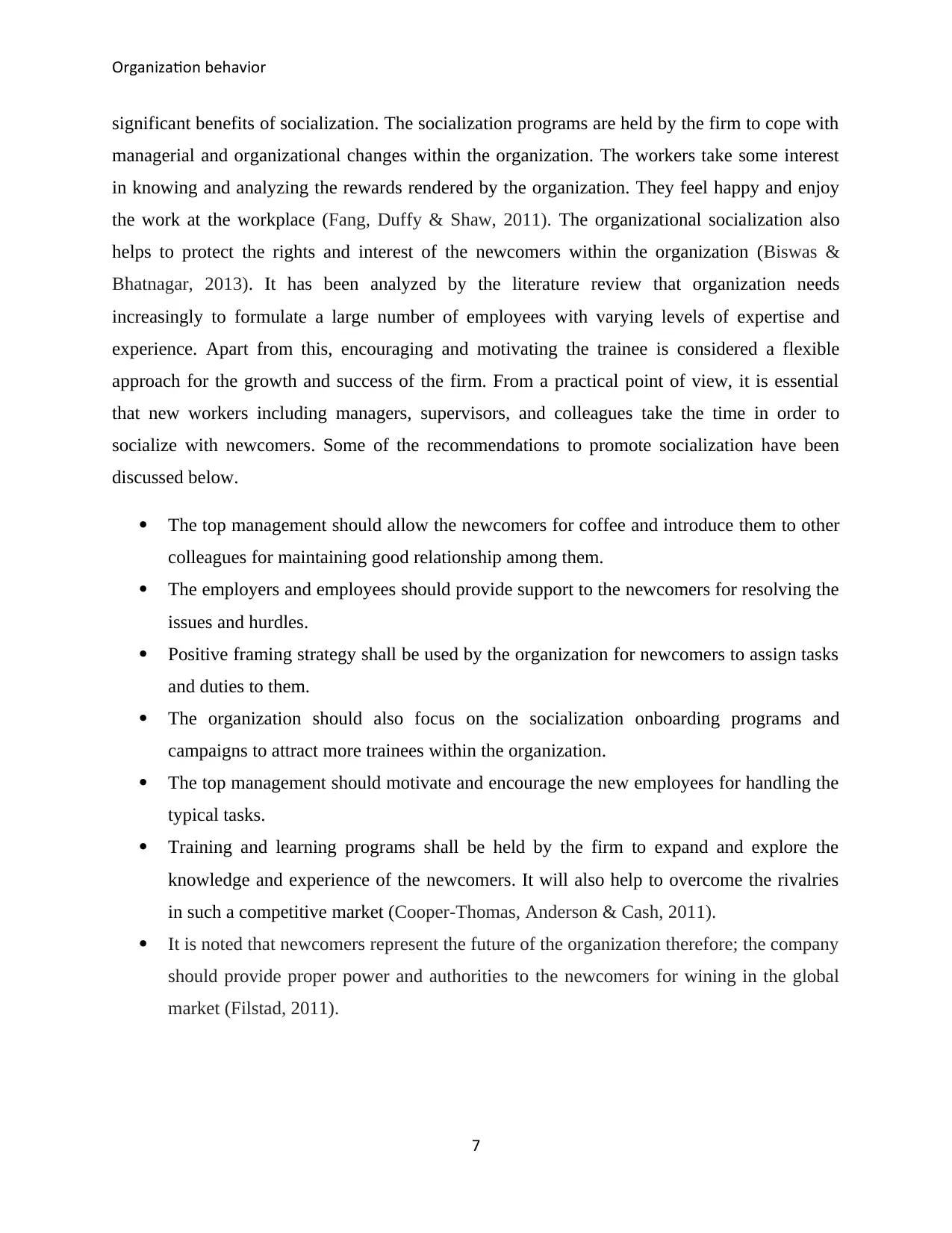
Organization behavior
significant benefits of socialization. The socialization programs are held by the firm to cope with
managerial and organizational changes within the organization. The workers take some interest
in knowing and analyzing the rewards rendered by the organization. They feel happy and enjoy
the work at the workplace (Fang, Duffy & Shaw, 2011). The organizational socialization also
helps to protect the rights and interest of the newcomers within the organization (Biswas &
Bhatnagar, 2013). It has been analyzed by the literature review that organization needs
increasingly to formulate a large number of employees with varying levels of expertise and
experience. Apart from this, encouraging and motivating the trainee is considered a flexible
approach for the growth and success of the firm. From a practical point of view, it is essential
that new workers including managers, supervisors, and colleagues take the time in order to
socialize with newcomers. Some of the recommendations to promote socialization have been
discussed below.
The top management should allow the newcomers for coffee and introduce them to other
colleagues for maintaining good relationship among them.
The employers and employees should provide support to the newcomers for resolving the
issues and hurdles.
Positive framing strategy shall be used by the organization for newcomers to assign tasks
and duties to them.
The organization should also focus on the socialization onboarding programs and
campaigns to attract more trainees within the organization.
The top management should motivate and encourage the new employees for handling the
typical tasks.
Training and learning programs shall be held by the firm to expand and explore the
knowledge and experience of the newcomers. It will also help to overcome the rivalries
in such a competitive market (Cooper-Thomas, Anderson & Cash, 2011).
It is noted that newcomers represent the future of the organization therefore; the company
should provide proper power and authorities to the newcomers for wining in the global
market (Filstad, 2011).
7
significant benefits of socialization. The socialization programs are held by the firm to cope with
managerial and organizational changes within the organization. The workers take some interest
in knowing and analyzing the rewards rendered by the organization. They feel happy and enjoy
the work at the workplace (Fang, Duffy & Shaw, 2011). The organizational socialization also
helps to protect the rights and interest of the newcomers within the organization (Biswas &
Bhatnagar, 2013). It has been analyzed by the literature review that organization needs
increasingly to formulate a large number of employees with varying levels of expertise and
experience. Apart from this, encouraging and motivating the trainee is considered a flexible
approach for the growth and success of the firm. From a practical point of view, it is essential
that new workers including managers, supervisors, and colleagues take the time in order to
socialize with newcomers. Some of the recommendations to promote socialization have been
discussed below.
The top management should allow the newcomers for coffee and introduce them to other
colleagues for maintaining good relationship among them.
The employers and employees should provide support to the newcomers for resolving the
issues and hurdles.
Positive framing strategy shall be used by the organization for newcomers to assign tasks
and duties to them.
The organization should also focus on the socialization onboarding programs and
campaigns to attract more trainees within the organization.
The top management should motivate and encourage the new employees for handling the
typical tasks.
Training and learning programs shall be held by the firm to expand and explore the
knowledge and experience of the newcomers. It will also help to overcome the rivalries
in such a competitive market (Cooper-Thomas, Anderson & Cash, 2011).
It is noted that newcomers represent the future of the organization therefore; the company
should provide proper power and authorities to the newcomers for wining in the global
market (Filstad, 2011).
7
Paraphrase This Document
Need a fresh take? Get an instant paraphrase of this document with our AI Paraphraser
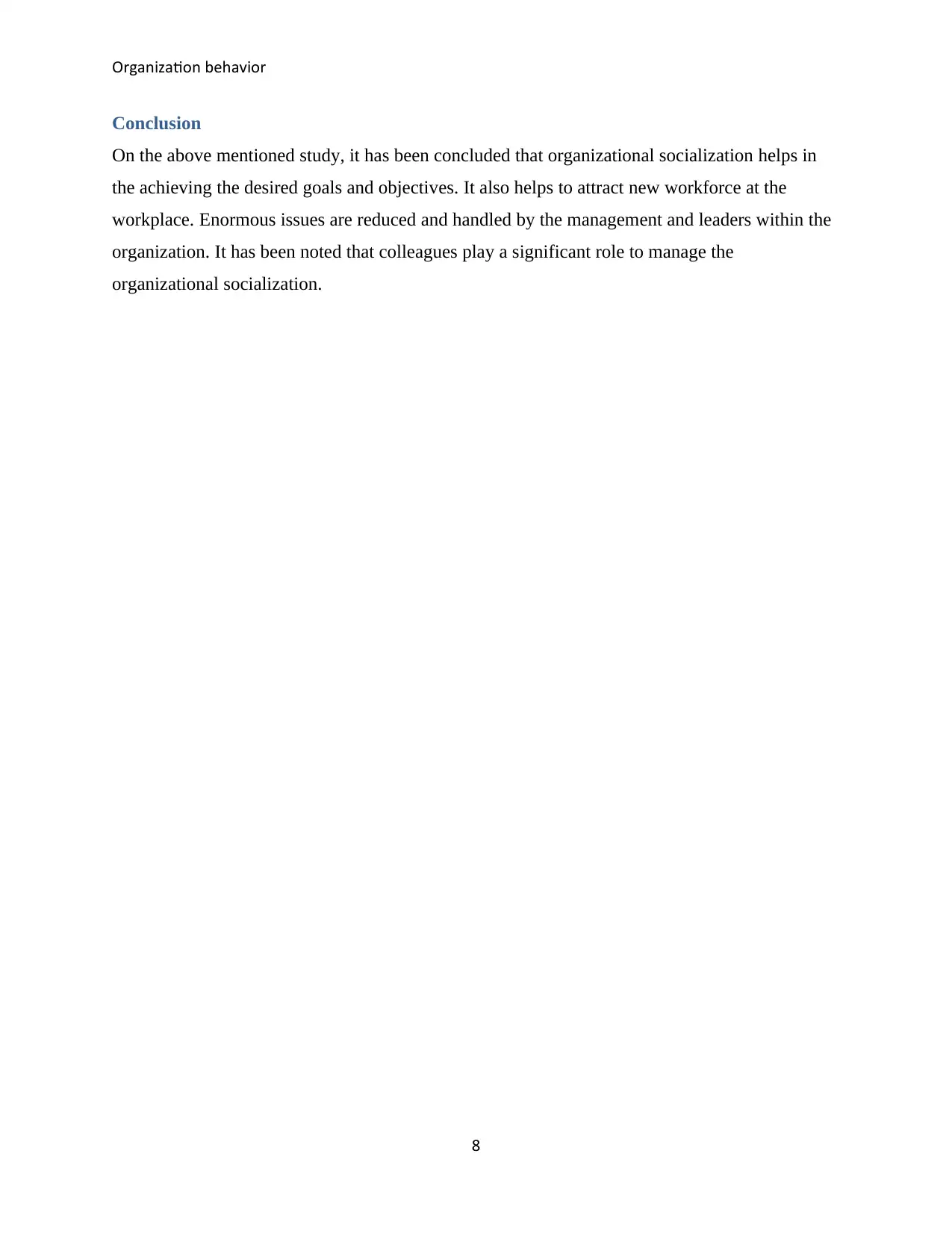
Organization behavior
Conclusion
On the above mentioned study, it has been concluded that organizational socialization helps in
the achieving the desired goals and objectives. It also helps to attract new workforce at the
workplace. Enormous issues are reduced and handled by the management and leaders within the
organization. It has been noted that colleagues play a significant role to manage the
organizational socialization.
8
Conclusion
On the above mentioned study, it has been concluded that organizational socialization helps in
the achieving the desired goals and objectives. It also helps to attract new workforce at the
workplace. Enormous issues are reduced and handled by the management and leaders within the
organization. It has been noted that colleagues play a significant role to manage the
organizational socialization.
8
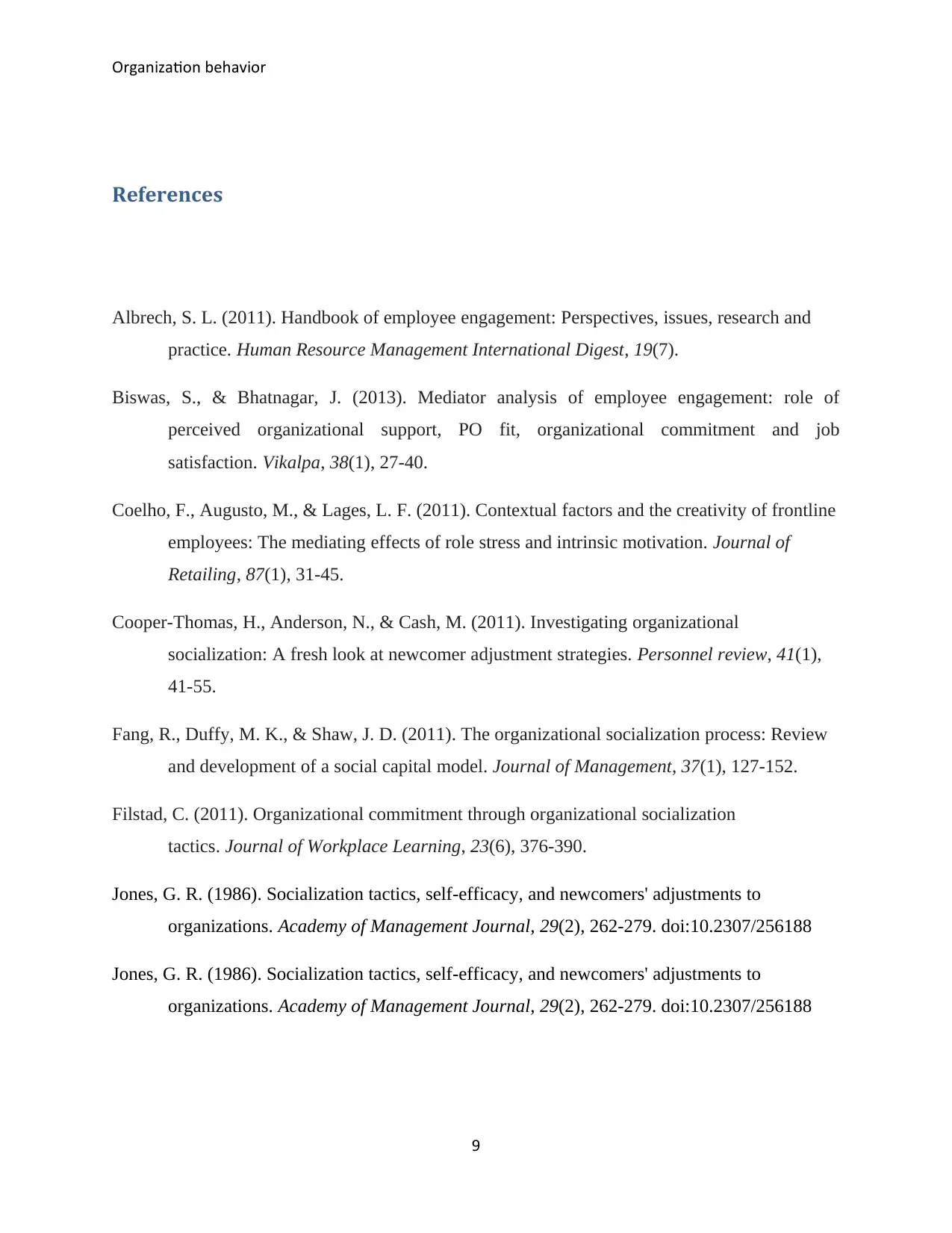
Organization behavior
References
Albrech, S. L. (2011). Handbook of employee engagement: Perspectives, issues, research and
practice. Human Resource Management International Digest, 19(7).
Biswas, S., & Bhatnagar, J. (2013). Mediator analysis of employee engagement: role of
perceived organizational support, PO fit, organizational commitment and job
satisfaction. Vikalpa, 38(1), 27-40.
Coelho, F., Augusto, M., & Lages, L. F. (2011). Contextual factors and the creativity of frontline
employees: The mediating effects of role stress and intrinsic motivation. Journal of
Retailing, 87(1), 31-45.
Cooper-Thomas, H., Anderson, N., & Cash, M. (2011). Investigating organizational
socialization: A fresh look at newcomer adjustment strategies. Personnel review, 41(1),
41-55.
Fang, R., Duffy, M. K., & Shaw, J. D. (2011). The organizational socialization process: Review
and development of a social capital model. Journal of Management, 37(1), 127-152.
Filstad, C. (2011). Organizational commitment through organizational socialization
tactics. Journal of Workplace Learning, 23(6), 376-390.
Jones, G. R. (1986). Socialization tactics, self-efficacy, and newcomers' adjustments to
organizations. Academy of Management Journal, 29(2), 262-279. doi:10.2307/256188
Jones, G. R. (1986). Socialization tactics, self-efficacy, and newcomers' adjustments to
organizations. Academy of Management Journal, 29(2), 262-279. doi:10.2307/256188
9
References
Albrech, S. L. (2011). Handbook of employee engagement: Perspectives, issues, research and
practice. Human Resource Management International Digest, 19(7).
Biswas, S., & Bhatnagar, J. (2013). Mediator analysis of employee engagement: role of
perceived organizational support, PO fit, organizational commitment and job
satisfaction. Vikalpa, 38(1), 27-40.
Coelho, F., Augusto, M., & Lages, L. F. (2011). Contextual factors and the creativity of frontline
employees: The mediating effects of role stress and intrinsic motivation. Journal of
Retailing, 87(1), 31-45.
Cooper-Thomas, H., Anderson, N., & Cash, M. (2011). Investigating organizational
socialization: A fresh look at newcomer adjustment strategies. Personnel review, 41(1),
41-55.
Fang, R., Duffy, M. K., & Shaw, J. D. (2011). The organizational socialization process: Review
and development of a social capital model. Journal of Management, 37(1), 127-152.
Filstad, C. (2011). Organizational commitment through organizational socialization
tactics. Journal of Workplace Learning, 23(6), 376-390.
Jones, G. R. (1986). Socialization tactics, self-efficacy, and newcomers' adjustments to
organizations. Academy of Management Journal, 29(2), 262-279. doi:10.2307/256188
Jones, G. R. (1986). Socialization tactics, self-efficacy, and newcomers' adjustments to
organizations. Academy of Management Journal, 29(2), 262-279. doi:10.2307/256188
9
⊘ This is a preview!⊘
Do you want full access?
Subscribe today to unlock all pages.

Trusted by 1+ million students worldwide
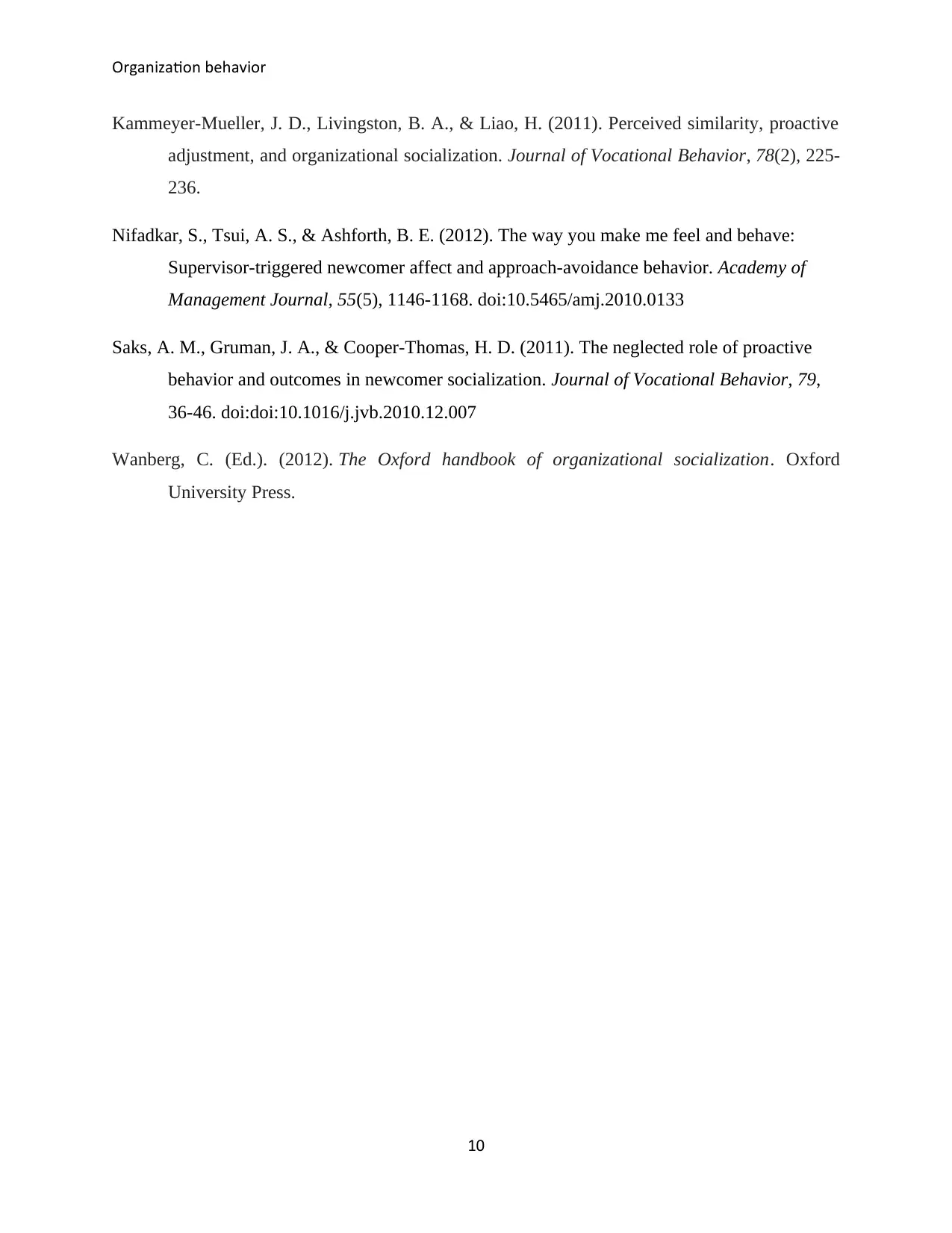
Organization behavior
Kammeyer-Mueller, J. D., Livingston, B. A., & Liao, H. (2011). Perceived similarity, proactive
adjustment, and organizational socialization. Journal of Vocational Behavior, 78(2), 225-
236.
Nifadkar, S., Tsui, A. S., & Ashforth, B. E. (2012). The way you make me feel and behave:
Supervisor-triggered newcomer affect and approach-avoidance behavior. Academy of
Management Journal, 55(5), 1146-1168. doi:10.5465/amj.2010.0133
Saks, A. M., Gruman, J. A., & Cooper-Thomas, H. D. (2011). The neglected role of proactive
behavior and outcomes in newcomer socialization. Journal of Vocational Behavior, 79,
36-46. doi:doi:10.1016/j.jvb.2010.12.007
Wanberg, C. (Ed.). (2012). The Oxford handbook of organizational socialization. Oxford
University Press.
10
Kammeyer-Mueller, J. D., Livingston, B. A., & Liao, H. (2011). Perceived similarity, proactive
adjustment, and organizational socialization. Journal of Vocational Behavior, 78(2), 225-
236.
Nifadkar, S., Tsui, A. S., & Ashforth, B. E. (2012). The way you make me feel and behave:
Supervisor-triggered newcomer affect and approach-avoidance behavior. Academy of
Management Journal, 55(5), 1146-1168. doi:10.5465/amj.2010.0133
Saks, A. M., Gruman, J. A., & Cooper-Thomas, H. D. (2011). The neglected role of proactive
behavior and outcomes in newcomer socialization. Journal of Vocational Behavior, 79,
36-46. doi:doi:10.1016/j.jvb.2010.12.007
Wanberg, C. (Ed.). (2012). The Oxford handbook of organizational socialization. Oxford
University Press.
10
1 out of 10
Your All-in-One AI-Powered Toolkit for Academic Success.
+13062052269
info@desklib.com
Available 24*7 on WhatsApp / Email
![[object Object]](/_next/static/media/star-bottom.7253800d.svg)
Unlock your academic potential
Copyright © 2020–2025 A2Z Services. All Rights Reserved. Developed and managed by ZUCOL.